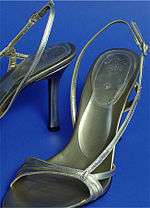Insolia
Insolia is a component in the design of the high-heeled shoe designed by New Hampshire podiatrist Dr. Howard Dananberg.[1] It reduces the pain associated with wearing high-heeled shoes by adjusting weight distribution back toward the heel through altering the geometry of the insole, rather than with padding.
Concept

With ordinary high-heeled shoes, the body weight is concentrated to the toes; this can make the wearer uncomfortable. The Insolia design shifts some of this weight back to the heel in an attempt to reduce high heel foot pain. The weight shift is accomplished by altering the geometry of the insole.
Technology

The original commercial implementation was an insole board that combined the structural elements of a high heel insole board with the patented Insolia contours. In early 2005, HBN Shoe developed the current implementation: an insole supplement that modifies a traditional high heel to give it the Insolia weight shifting geometry. This implementation is protected in the EU by one issued patent and other patents are pending in the US, the EU, and elsewhere. Insolia now also markets an after-market version that can be easily installed in shoes by consumers via its website.
Marketing
The consumer version of the Insolia Insert is being carried by a variety of retailers.[2]
The technology is also marketed in Australia, Canada, China, Czech Republic, France, Germany, Hong Kong, Italy, Japan, Spain, Switzerland, and the United Kingdom.
Early in 2005, Insolia reported that Qantas, a major Australian airline, had chosen shoes containing the Insolia component as necessary footwear for its 7,000 flight attendants.
References
- "Lemelson-MIT Program". lemelson.mit.edu. Retrieved 2020-02-01.
- "Archived copy". Archived from the original on 2007-05-13. Retrieved 2007-05-05.CS1 maint: archived copy as title (link)